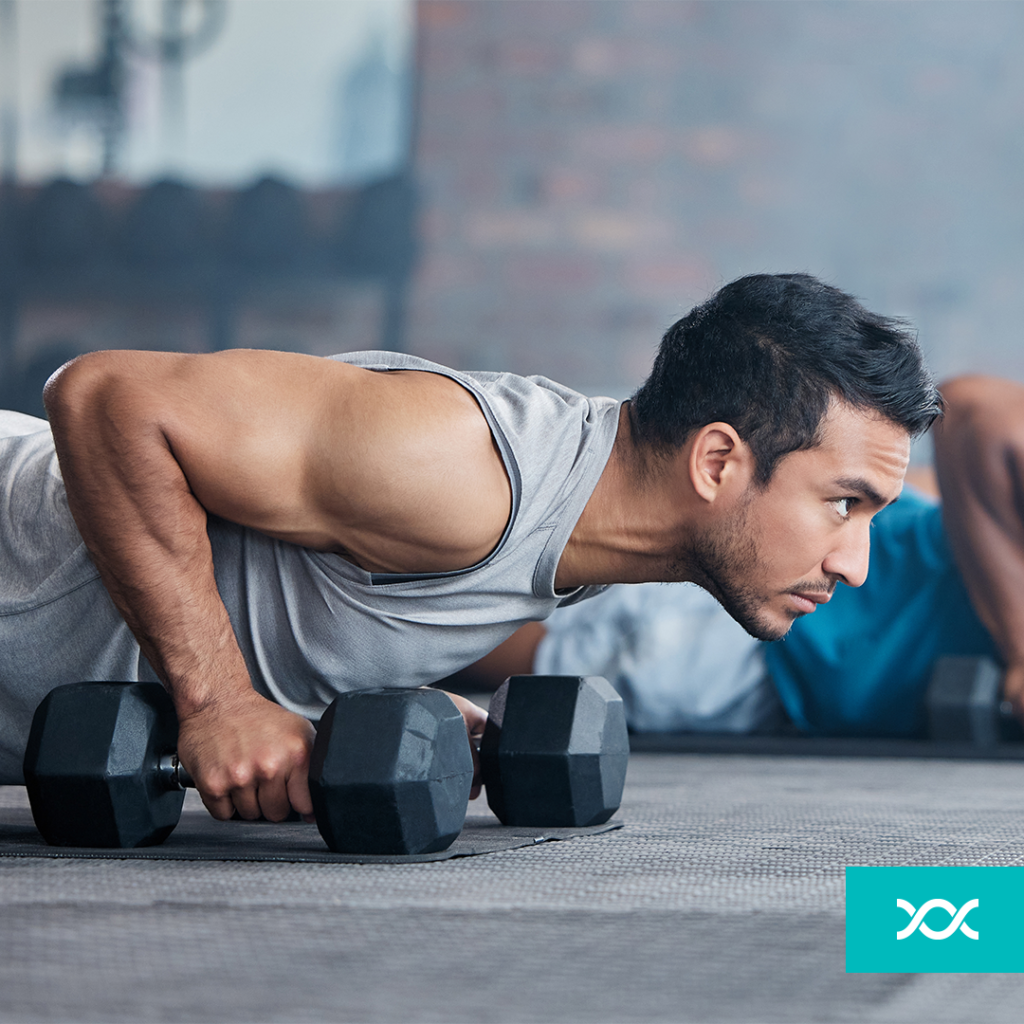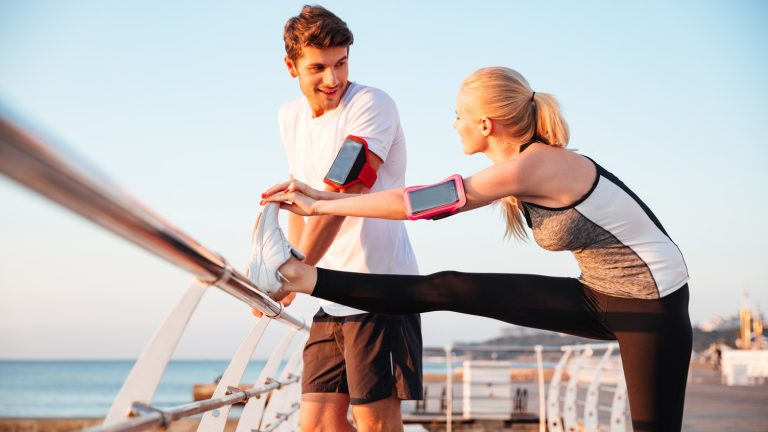You don’t need a celebrity trainer or pricey gym membership, just determination and your genes. Learn what they can teach you and help you optimise exercise and sports goals!
We, humans, are wildly different from each other, and exercise is no exception. So, it’s not very likely you’ll benefit from the same training plan as your best friend – even if you have the exact same goal!
But instead of letting that drag you down, find the missing information that will allow you to optimise your training.
The sporty genes
Genetic variations influence your athletic predispositions. No matter your level – pro athlete, enthusiast, or just a regular person wanting to reap the benefits of exercise – the knowledge revealed by these analyses is valuable to anyone.
Your genetic predispositions point out your strong and weak links so you can:
- anticipate where you might progress slower,
- know which exercises to prioritise,
- learn to structure and plan your training and recovery, and more.
We introduce the most relevant analyses – what they mean, how they affect your athletic performance, and even some real-life examples of how to use them.


Muscles
Can’t talk about sports without mentioning muscles, right? Let’s see how genes impact muscles and their performance.
Endurance predisposition
Endurance is your body’s capacity to sustain an exercise for an extended time. In other words, to keep your body active over an extended period.
Based on this predisposition, you can adjust your training to reach your goals.
Here’s an example – want to run 10 km, but you have a lower endurance predisposition? Compared to someone with a higher predisposition, you’ll benefit from more weekly runs at a lower intensity (jogging instead of interval) but longer distances.
Power predisposition
Power is the ability to generate force at high speed, so it is a combination of speed and strength.
Power predisposition is heavily influenced by the proportion of the two types of muscle fibre (fast- vs slow-twitch).
- Sprinters (power) have mostly fast-twitch fibres.
- Marathoners (endurance) tend to have mostly slow-twitch fibres.
Knowing your predisposition helps you understand your progress and adjust the exercises. Power-focused exercises include kettlebell swings, mountain climbers, jump squats, deadlifts, and box jumps.
Muscle volume
Big muscles are not just a result of hard training; genes also determine the increase in muscle volume.
But to properly adjust your training, you must know what you want – bigger or stronger muscles?
- If you want to get stronger, do strength training.
- If you want bigger muscles, do hypertrophy training which creates new muscle tissue, making muscles larger and able to generate more force.
In practice, this might mean:
- To build strength, use heavy weights and do low repetitions (around 1–5 reps per set).
- To stimulate muscle growth, go for higher repetitions (around 6–15 reps per set).
Muscle cramping
Cramps are sudden, involuntary contractions of one or more muscles, often painful. They can occur during physical activity or unrelated, such as at night.
They have many causes and potential solutions you can try in practice if you’re more predisposed to muscle cramping.


Heart
When we talk about sports, we also can’t forget the motor that runs this complex machine we call our body – the heart.
Acute heart rate response to exercise
Heart rate increases as you exercise and returns to normal when you finish.
Your body speeds up your heart rate to meet its increased need for oxygen, which means that an increase in heart rate contributes strongly to your ability to sustain aerobic exercise.
Your heart rate recovery immediately after exercise is also an indicator of your fitness – the faster the recovery, the better your fitness.
The increase during and recovery immediately after exercise is called “acute heart rate response to exercise”.
Knowing how your heart rate increases during exercise helps you achieve your goals because working out in different heart rate zones brings different benefits.
- Zone 1 (walking, leisurely cycling, stretching, taking the stairs) is for warmup or active recovery.
- Zone 2 (easy effort – fast walk, slow run or biking) improves endurance, muscular fitness, and insulin sensitivity. Here, you burn the most calories from fat.
- Zone 3 or aerobic zone (medium effort) increases speed and power.
- Zone 4 or threshold (high effort, HIIT workout, tempo running) brings the most benefits to your heart and VO2max improvement.
Resting heart rate
Besides increasing your heart rate recovery, regular exercise also lowers your resting heart rate.
This indicates that your heart has gotten stronger, and your vascular system has become more adept.
An average healthy adult’s resting heart rate range is 55–85 bpm (beats per minute). Athletes or very active people often have a resting heart rate of around 40 bpm.
The effects of regular activity on the heart are not the same for everyone, so it’s good to know your predisposition when monitoring your heart rate changes.
You can track both heart-related metrics with a smartwatch or fitness tracker.
By tracking your heart rate, it helps you mark your baseline and see how it improves with regular exercise.
Such devices also monitor which zones you’re training in, allowing you to adjust the intensity according to your goals.


VO2max
You’ve probably seen it somewhere (your smartwatch, maybe?), but you don’t really know what it means? In the simplest terms, VO2max measures your aerobic fitness level.
Like every cell, your muscles need oxygen to function. And the more intense the activity, the more oxygen they require.
But your oxygen consumption is limited to a certain point we call the VO2max, the maximum volume of oxygen your body can use within one minute.
MyLifestyle DNA test analyses your genetic predisposition for two factors – VO2max potential and VO2max trainability.
The first gives you an idea of your baseline, and the second is about your ability to increase your aerobic fitness in response to training.
If you’re not a pro athlete – who does it in specialised laboratories – you can estimate your VO2max with a smartwatch or fitness tracker. Then monitor how it improves with regular exercise.
Increased VO2max score doesn’t mean you’ll run faster. But it will make going faster and maintaining a steady pace in any aerobic activity easier.


More sports-related analyses
Our MyLifestyle DNA test‘s chapter “Sport and recreation” includes more sporty analyses for you to use. They are:
- Post-exercise recovery enables you to train at higher volumes and intensities, prevent injury and overtraining.
- Soft-tissue injury is the most common sports-related injury, and if you have a less favourable genotype, you can be careful about proper training, warm-up, and nutrition.
- Inflammation sensitivity can impact your recovery and muscle development.
- Lean body mass, or total body weight without the fat, is heavily influenced by genetics, with heritability up to an astounding 84 per cent.
- Exercise and insulin sensitivity – aerobic exercises temporarily increase your insulin sensitivity, which protects you from diabetes and other health complications.
- Warrior gene is a genetic variant associated with better stress handling, which vigorous physical activity also counts as.
But that’s not all – MyLifestyle’s other chapters, “Diet and nutrition” and “Body and mind“, let you approach exercise from an even broader perspective!
- Optimise your weight loss efforts by combining sports predispositions and analyses from Diet and nutrition chapter.
- Manage stress and get quality sleep with relevant analyses from the Body and mind chapter.
- Keep ageing at bay with exercise, nutrition and skin-related analyses from Body and mind chapter.


What more could you want?
How about free new analyses!
Once you get our DNA test, that’s not the end of the story.
We regularly add new analyses, and you receive them immediately and completely free. If you have a Premium test, you receive at least one new analysis a month!
Ready to crush your sports goals and collect all the benefits of being active?
Knowing your genetic predispositions is the first step in creating an optimised personal exercise plan. And the second step? Motivation and determination.
So let’s go burn that fat and build those muscles!

















